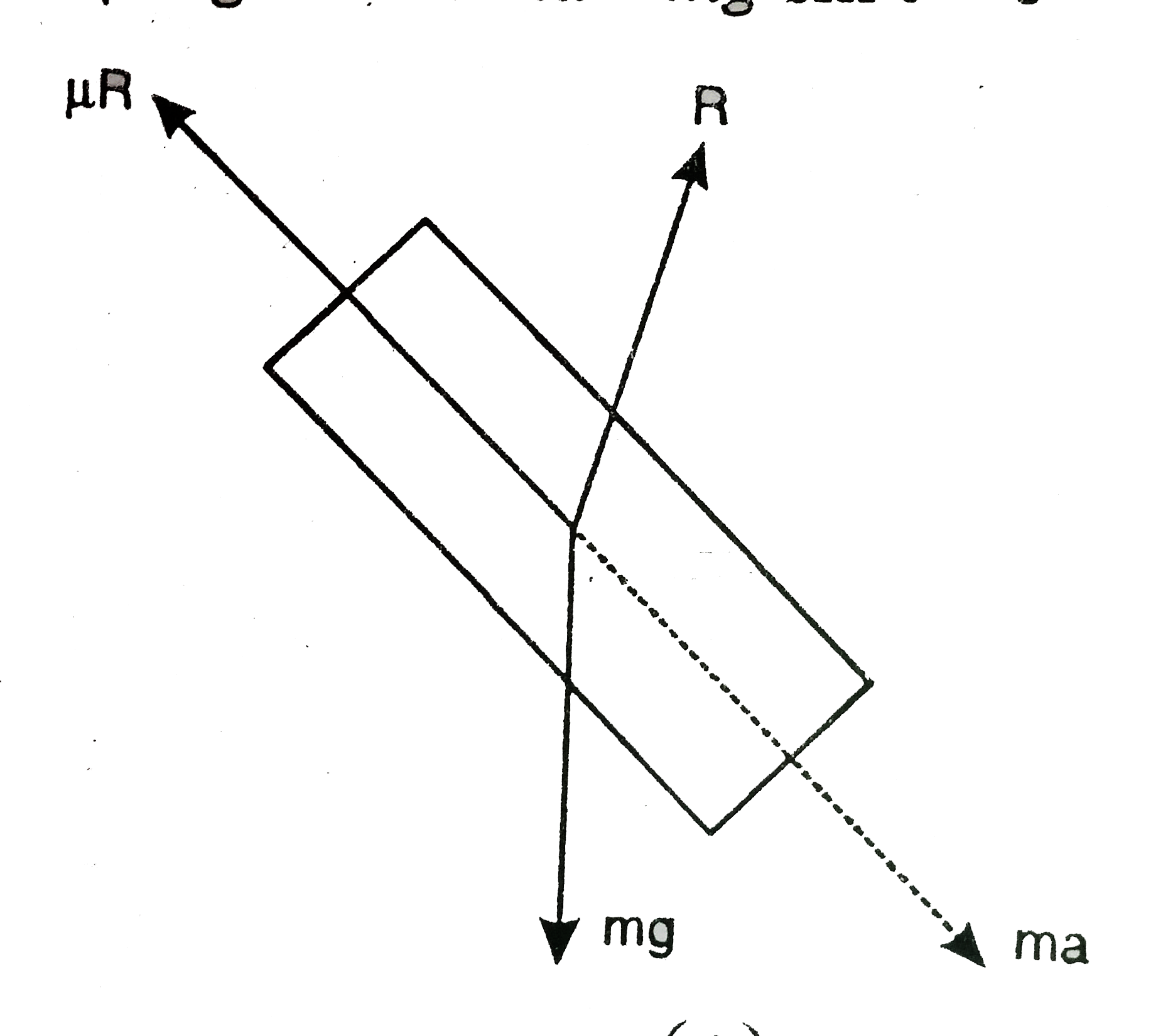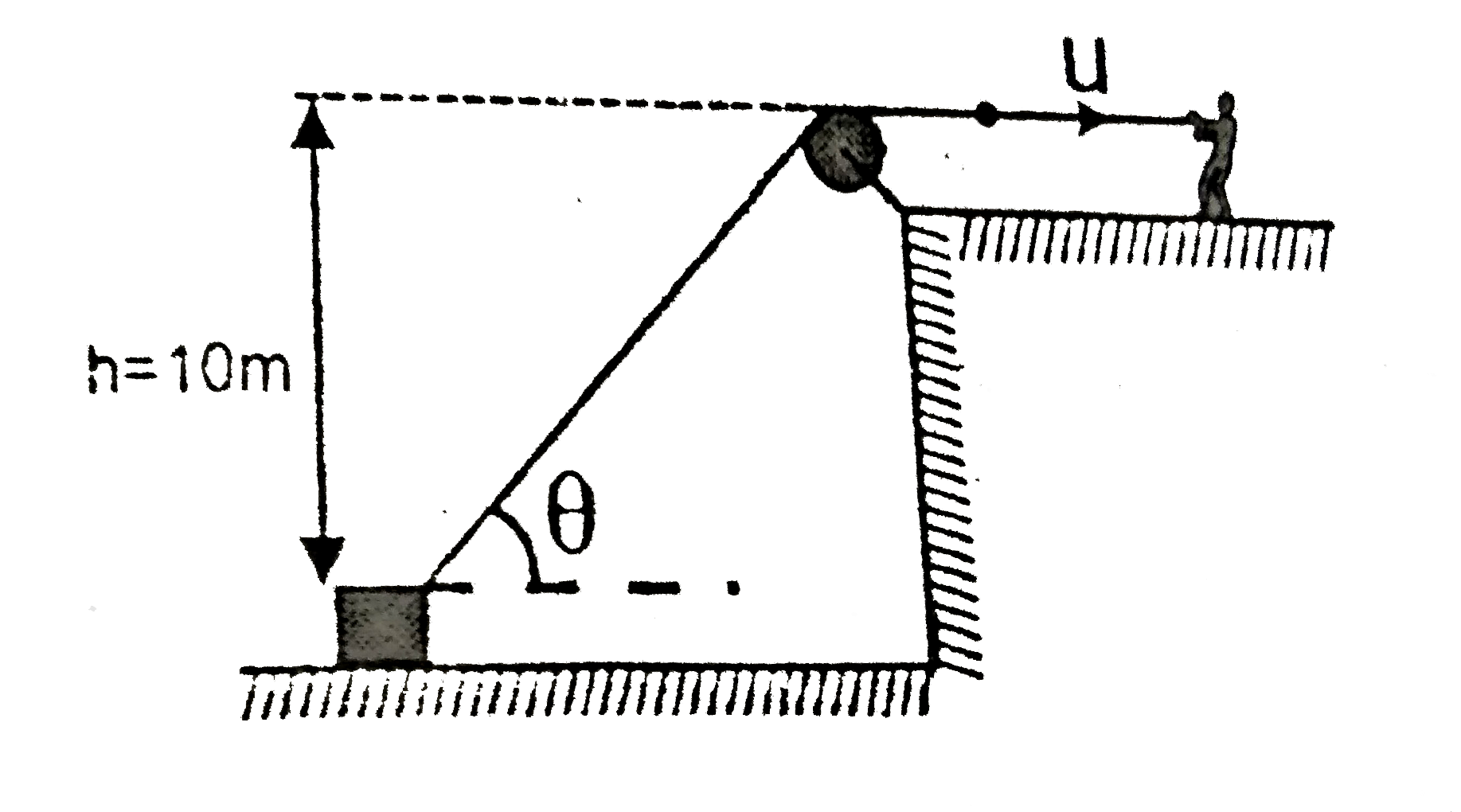A car is going at a speed of 21.6 km/hr when it encounters a 12.8 m long slope of angle 300 figure. 12√3. Shwo tht no matter how hard the driver applies the brakes, tehcar will reach the bottim with a speed greater than 36 km/hr. Take g=10ms2

Hardest brake indicates that maximum force of friction is developed between car's tyre and road.
Maximum frictioN/Al force =μR
From the free body diagram,
R−mgcosθ=0
→R=mgcosθ……..i
andμR+ma−mgsinθ=0 ………ii
→μmgcosθ+ma−mgsinθ=0

→mgcosθ+a−10×(12)=0
→a=5−[1−2√3]×10(√32)
=5−2.5=2.5ms2
S=12.8ms2
u=6ms,velocityattheendof∈cl∈e<br>v=sqrt(u^2+2as)<br>=sqsrt(6^2+2(2.5)(12.8))<br>=sqrt(36+64)
=10ms=36kmhr<br>Hence,theharderthedriverappliesthebrakes,mthelowerwillbethevelocityofthecrwhenitreachesthegroundi.e.at36 km/hr.
Topper's Solved these Questions
- FRICTIONBOOK - HC VERMA ENGLISHCHAPTER - FRICTIONEXERCISE - Questions for short Answer
11 Videos
- FRICTIONBOOK - HC VERMA ENGLISHCHAPTER - FRICTIONEXERCISE - Objective -2
5 Videos
- FLUID MECHANICSBOOK - HC VERMA ENGLISHCHAPTER - FLUID MECHANICSEXERCISE - All Questions
90 Videos
- GRAVITATIONBOOK - HC VERMA ENGLISHCHAPTER - GRAVITATIONEXERCISE - Question for short Answers
18 Videos
Similar Questions
A train is travelling at a speed of 90km/h. Brakes are applied so as to produce a uniform acceleration of −0.5m/s2. Find how far the train will go before it is brought to rest.
View SolutionA car is moving with constant speed of 10m/s on a horizontal circular path of radius 10√3m . A bob of mass m suspended through a light string from the roof of the car. What is the angle made by the string with the vertical if the bob is stationary with respect to the car? (g = 10 m/s2)
View SolutionA man can walk on the shore at a speed v1 = 6 km/hr & swim in still water with a speed V2 = 5 km/hr. If the speed of water is V3 = 4 km/hr, at what angle should he head in the river in order to reach the exactly opposite point of the other shore in "shortest time including his swimming & walking?
View SolutionA ball is thrown at a speed of 40 m/s at an angle of 600 with the horizontal. Find a. the maximum height reached and b. the range of te ball. Take g=10ms2.
View SolutionA particle of mass 0.2 kg has an intial speed of 5ms−1 at the bottom of a rough inclined plane of inclination 30∘ and vertical height 0.5 m . What is the speed of the particle as it reaches the top of the inclined plan ? (Take μ=1/√3,g=10ms−2 ) .
View SolutionA particle is projected from the bottom of an inclined plane of inclination 30∘ with velocity of 40m/s at an angle of 60∘ with horizontal. Find the speed of the particle when its velocity vector is parallel to the plane. Take g=10m/s2.
View SolutionA simple pendulum is suspended from the ceiling of a car taking a turn of radius 10 m at a speed of 36 km/h. Find the angle made by the string of the pendulum with the vertical if this angle does not change during the turn. Take g=10ms2.
View SolutionA ball is thrown from a field with a speed of 12.0 m/s at an angle of 450 with the horizontal. At what distance will it hit the field again ? Take g=10.0ms2
View SolutionA child in danger of drowning in a river is being carried downstream by a current that flows uniformly at a speed of 2.5km/h. The child is 0.6 km from shore and 0.8 km upstream of a boat landing when a rescue boat sets out. If the boat proceeds at its maximum speed of 20km/h with respect to the water, what angle does the boat velocity v make with the shore? How long will it take boat to reach the child?
View SolutionIn the figure shown, a person pulls a light string with a constant speed u=10m/s. The other end of the string is tied to a very small block which moves on a smooth horizontal surface. Find the angle 'θ'when the block 3 leaves the surface . Take g=10m/s2.

View Solution
